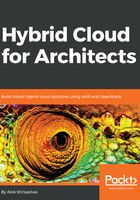
Isolated use case
This is one of the simplest use cases. In this, an enterprise runs some applications in a public cloud and others in a private cloud, the applications don't communicate among themselves regularly, but may transfer data using a batch process.
It might also be the case that one application uses the services of the other - with the communication over an API.
A good use case in this category would be development in public/production on a private cloud (or vice versa).
In the following diagram, the left side is the public cloud and the right side is the private cloud. The applications running on both sides are isolated - which means a nominal delay in the communication path is acceptable:

In the preceding example, the environments are completely separated and the compiled/tested code and data may only be moved between the environments manually, or by using a continuous deployment process.
Now, one can choose to keep the development or the production environment in a cloud. Let us look at the rationale behind two use cases:

Based on this, we can say that dev/test would be a good fit for the public side of the hybrid cloud, while the production system with the production data can sit inside the private cloud/data center as shown previously.